SUBJECTS
GRADE
Show Results
My Many Colored Days by Dr. Seuss
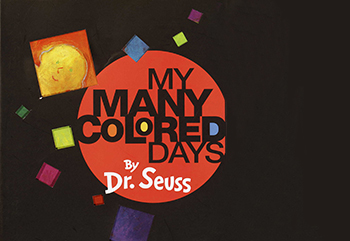
Lesson Summary
- Promote understanding of emotions through the book My Many Colored Days.
- Explore the energy of emotions in a healthy, fun way with creative movement.
Lesson Plan and Procedure
Lesson Key Facts
- Grade(s): K, 1, 2, 3
- Subject(s): Dance, English Language Arts
- Duration of lesson: 30-45 minutes
- Author(s): Miriam Bowen
Experience/Identify
Divide the class by assigning students a number: one or two. Have them gather in groups of their number. (You might identify them as “Thing 1 Group” and “Thing 2 Group” from The Cat in The Hat.)
Have one group sit in a long row on one side of the room. Have the other group sit on the other side of the room in a row.
Teacher: One group will explore movement as a performer, while the other group will practice being the observing audience. We'll change roles so everyone gets to participate.
Teach or review audience etiquette.
Teacher: Those who are observing, watch the performers without talking. Performers, stay in your personal bubble without bumping into anyone.
Begin reading the book.
Teacher: “Some days are yellow. Some are blue. On different days, I’m different too. You’d be surprised how many ways I change on Different Colored Days. On Bright Red Days, how good it feels to be a horse and kick my heels.”
Pause the reading to instruct students.
Teacher: Thing 1 Group, move around and gallop your heels when I start the music.
Play “Wild Horseman” (Schumann).
After they have galloped for approximately 35 seconds, tell them to return to their spots, and then instruct Thing 2 Group to try galloping. After 35 seconds, stop the music and have the group freeze in a shape.
Teacher: “On other days I’m other things. On Bright Blue Days, I flap my wings.”
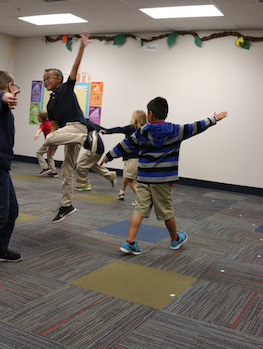 Play “Rondeau” (Bach).
Play “Rondeau” (Bach).
Have Thing 2 Group explore moving with their arms. After 35 seconds of music, have them move back to their audience row and invite Thing 1 Group to explore moving with their arms.
Continue alternating each group through each page or color of the book, giving everyone a chance to perform and observe.
Teacher: “Some days, of course, feel sort of Brown. Then I feel slow and low, low down.” How slow can you move? Can you move in interesting ways on a low level? Can you move one body part slowly?
Play “The Elephant” (Saint-Saens).
Teacher: “Then comes a Yellow Day. And, wheeeeeeeeeee I’m a busy, buzzy bee.” Bees move in a zigzag pattern from flower to flower. Can you find ways of moving in zigzag pathways?
Play “Flight of the Bumble Bee” (Rimsky-Korsakov).
Teacher: “Gray Day. . . . Everything is gray. I watch. But nothing moves today.” Can you stop and hold still? What can you do with your body to make your shape interesting to look at?
Let the students stand still in silence.
Teacher: “Then all of a sudden, I’m a circus seal! On my Orange Days that’s how I feel.” What kind of ways can you move that are tricky? Imagine you are balancing a ball on your nose, juggling balls, or tiptoeing on a tight rope?
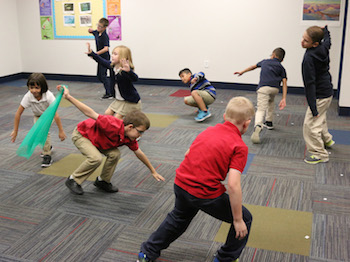
Play “The Entertainer” (Joplin).
Teacher: “Green Days. Deep, deep in the sea. Cool and quiet fish. That’s me.” There are high, medium, and low levels of the ocean. Will you swim down in the abyss or stay up near the sun like a dolphin leaping out of the water?
Play “Air” (Bach). Encourage performers to explore all levels as they move. You may also refer to strokes from swim lessons.
Teacher: “On Purple Days I’m sad. I groan. I drag my tail. I walk alone.” Can you find a place to walk alone with a sad face, dragging your legs or arms? (You could comment that this is so sad to watch that you don’t want to stay on the page too long.)
Play “Moonlight Sonata” (Beethoven).
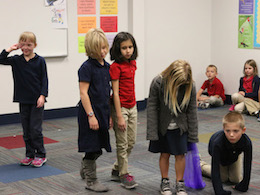
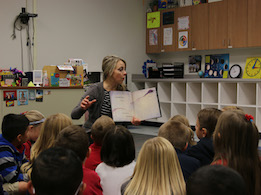

Teacher: “But when my days are Happy Pink it’s great to jump and just not think.”
Play “Chinese Dance” (Tchaikovsky). Encourage students to change their sad faces to happy faces and jump with two feet.
Teacher: “Then come my Black Days. Mad. And loud. I howl. I growl at every cloud.”
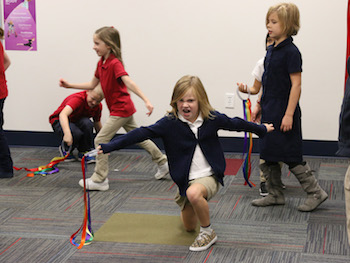 Before sending the students out to move, remind them that their bodies are doing the exploring, not their mouths. They need to find ways to show a howl or growl or a movement that would look mad, such as stomping feet.
Before sending the students out to move, remind them that their bodies are doing the exploring, not their mouths. They need to find ways to show a howl or growl or a movement that would look mad, such as stomping feet.
Play “Russian Sailors Dance” (Gilere).
Teacher: “Then comes a Mixed-Up Day. And WHAM! I don’t know who or what I am!”
Play “Batik” (Worsley).
Have the students choose some of their favorite colors. Encourage them to make their movements so clear the audience can guess the color they are thinking of.
After Thing 1 Group and Thing 2 Group have each had a turn dancing this mixed-up color idea, bring both groups together to listen to the last page.
Teacher: “But it all turns out all right, you see. And I go back to being me.”
Connect/Analyze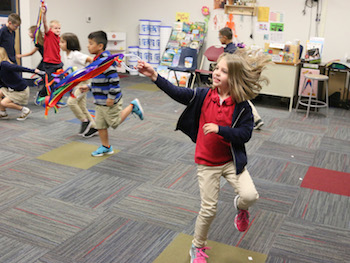
Have the students reflect on the colors that are most meaningful to them. This is a great time to discuss things—for example, is it okay to be sad? What do we do when we have black, mad days? Bring up that doing physical things such as running can help in our black moments.
Encourage the students to notice their emotions throughout the week. For a follow-up, you can have them comment on what they noticed, how they felt, or what they did while experiencing that emotion.
Learning Objectives
- Try new ways of moving while connecting them to a certain emotion.
- Explore new movement ideas through specific emotions and colors.
- Identify and understand information from illustrations and colors.
Utah State Board of Education Standards
This lesson can be used to meet standards in many grades and subject areas. We will highlight one grade’s standards to give an example of application.
Grade K Dance
Standard K.D.CR.1: Demonstrate willingness to try new ideas when creating dance.
Standard K.D.P.1: Maintain personal space while in group formations and start and stop on time.
Standard K.D.CO.1: Recognize and name emotions experienced when watching, improvising, or performing dance and relate it to a personal experience.
Grade K English Language Arts
Standard K.R.5: With prompting and support, ask and answer questions about key details in text. (RL & RI)
Equipment and Materials Needed
- Seuss, Lou Fancher, and Steve Johnson. My Many Colored Days. London: Red Fox, 2001.
- Music tracks:
- Different Colored Days: “Contrasts” (Jensen)
- Red: “Wild Horseman” (Schumann)
- Blue: “Rondeau” (Bach)
- Brown: “The Elephant” (Saint-Saens)
- Yellow: “Flight of the Bumble Bee” (Rimsky-Korsakov)
- Gray: Silence
- Orange: “The Entertainer” (Joplin)
- Green: “Air” (Bach)
- Purple: “Moonlight Sonata” (Beethoven)
- Pink: “Chinese Dance” (Tchaikovsky)
- Black: “Russian Sailors Dance” (Gliere)
- Mixed-Up: “Batik” (Worsley)
Additional Resources
These links offer additional information and ideas:
- https://www.psychologytoday.com/blog/communication-success/201410/how-increase-your-emotional-intelligence-6-essentials
- https://open.spotify.com/user/ktgolding/playlist/2WVxKwYb8JOISPvIeB1zlY
Image References
Image 1: Penguin Random House (https://www.penguinrandomhouse.com/books/43086/my-many-colored-days-by-dr-seuss/9780679875970/).
Images 2–8: James Huston.

www.education.byu.edu/arts/lessons
 Download
Download